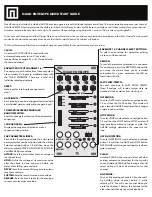
61
Flanger effect parameters (parameter type: FLANGE)
For effect type
36
of the preceding "Effect type" table, the following four parameters can be adjusted.
1.
Eff Level
Adjust the effect return level:
0~99
2.
Rate
Adjust the speed of modulation. Range:
0.01--2.00 Hz
3.
Depth
Adjust the depth of modulation. Range:
0--99
4.
Mod Delay
Adjust the modulation delay. Range:
0--200
5.
Feedback
Adjust the number of modulation repeats. Range:
0--99
Delay pitch effect parameters (parameter type: DELAY PITCH)
For effect type
38
of the preceding "Effect type" table, the following four parameters can be adjusted.
1.
Eff Level
Adjust the effect return level:
0~99
2.
Pitct
Adjust the amount of pitch shift. Range:
-24--0--+24
*
+/-12
is one octave.
+/-24
is two octaves.
3.
Adjust
Make fine adjustments to the amount of pitch shift. Range:
-50--0--+50
*
+50
is a semitone sharp.
-50
is a semitone flat.
4.
Delay Time
Adjust the delay time until the pitch-shifted sound is heard. Range:
0--500 ms
5.
Feedback
Adjust the number of delay repeats. Range:
0--99
Mono pitch effect parameters (parameter type: MONO PITCH)
For effect type
37
of the preceding "Effect type" table, the following three parameters can be adjusted.
1.
Eff Level
Adjust the effect return level:
0~99
2.
Pitch
Adjust the amount of pitch shift. Range:
-24--0--+24
*
+/-12
is one octave.
+/-24
is two octaves.
3.
Adjust
Make fine adjustments to the amount of pitch shift. Range:
-50--0--+50
*
+50
is a semitone sharp.
-50
is a semitone flat.
4.
Mode
Select the processing method. Range:
1--3
The VF160 provides 100 scene memories (Scene numbers 00 to 99). You can store a set of desired parameter set-
tings to each memory. Items to be stored include all parameters set by the channel parameter edit and effect edit
modes, as well as all channel fader levels. Furthermore, you can give a desired scene name with up to 16 alphanu-
meric or symbolic characters to each scene memory.
In addition to 100 scene memories, the VF160 also provides 10 temporary memories (Temporary numbers 00 to
09). Note that all the setting stored in a temporary memory disappears when turning off the power.
Flashing
Storing to a scene memory
You can store the current settings to a scene memory
by the following procedure.
1. Press the [SCENE-STORE] key.
The display shows the screen for selecting the scene num-
ber.
2. Use the [JOG] dial to select the desired scene number to which
you want to store the current settings, and press the [ENTER/
YES] key.
The display shows the screen for editing a title of the s e -
lected scene number. The name of the program which you
worked before entering the scene memory mode is dupli-
cated to the name of the selected scene number, whose first
character flashes, showing that it can be edited.
3. Enter the desired scene name using the JOG dial for selecting
a character and using the [REWIND]/[F FWD] keys for mov-
ing the editing (flashing) point.
You can specify a scene name with up to 16 alphanumeric
or symbolic characters and can see up to 14 characters on
the display. The following characters can be entered:
A to Z, a to z, 0 to 9,
+ - * / # & ! ? ( ) [ ] < > : . _ ,<- ->
4. After completing the scene name entry, press the [ENTER/
YES] key.
The display will change to the Normal display of the pro-
gram whose scene name has been set.
Scene Memory
Summary of Contents for VF-160
Page 153: ......
















































